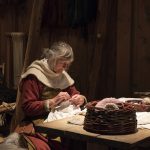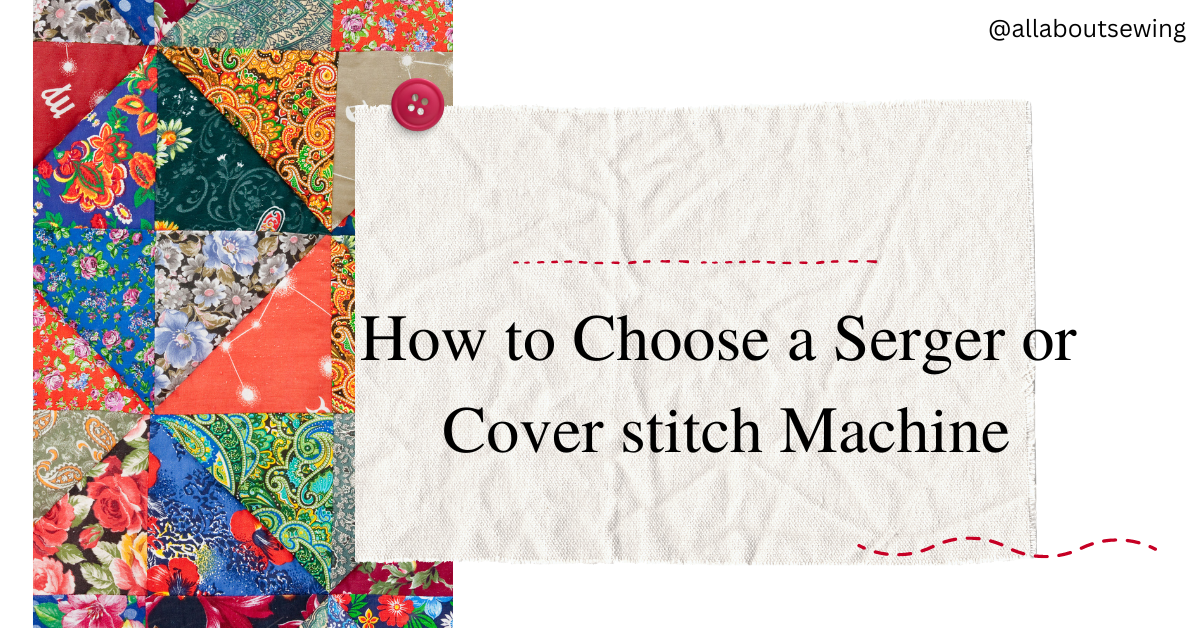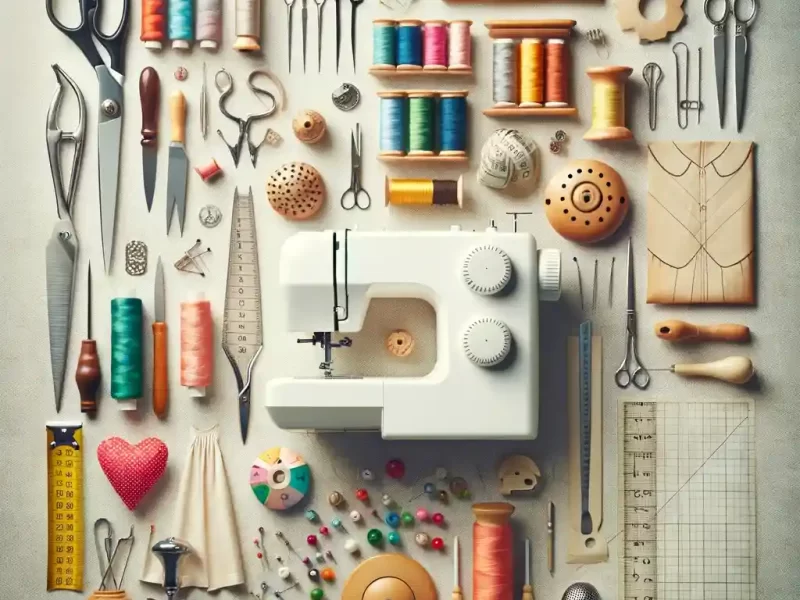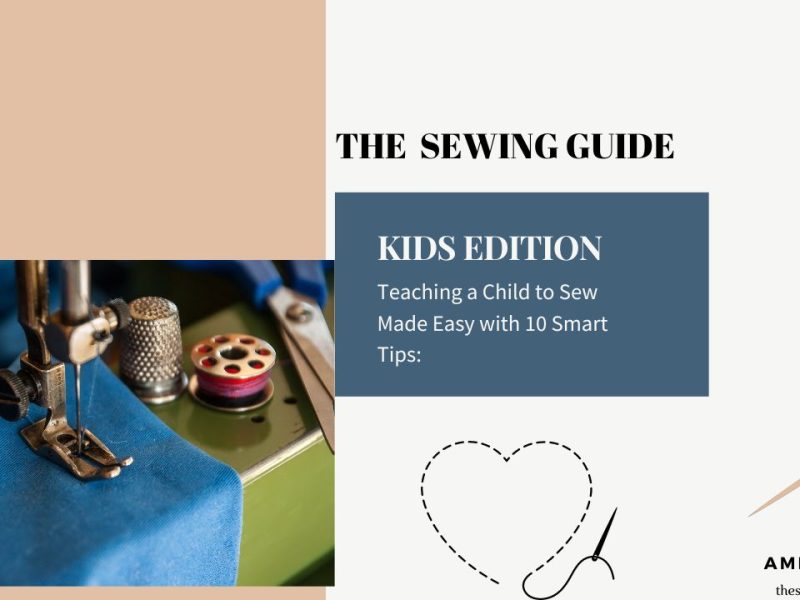Two names, two different uses. Let us go over them briefly and see how each of these machines can help us with our sewing projects.
What Is a Serger Machine?
The term “serger” is used more often in North America than in other parts of the world, and occasionally you’ll hear the term “merrow” machines. Why? Because Merrow is the brand name of the company that made the first serger machines, the term has become accepted in some circles as a generic term for any overlock machine.
Serger vs. overlock sewing machine
Serger and overlock machines are one and the same – they are just two different names for the same machine.

A serger or overlock machine basically sews over the edge of a piece of fabric, binding the raw edge with thread through a combination of needles and looping mechanisms. This prevents the edge of the fabric from fraying and can sometimes serve as a hem for a garment.
Serger machines can also be used to sew two pieces of fabric together, tying the raw edges together as they are sewn. Most sewing machines can also trim excess fabric from the edge of the seam with a special blade.
The number of needles and eyelets on the machines varies depending on the different functions for which the machine is to be used, and they can be used for both woven and knit fabrics.
What Is a Cover Stitch machine?
Coverstitch machines use a combination of needles and a single looper to sew seams or hems, and are especially useful for knit fabrics. Their multiple needles work together to sew a straight stitch on the top of the fabric, while the looper creates a loose chain stitch on the bottom of the fabric.
When a cover stitch machine is used, it also binds the raw edge of the fabric so that excess material that goes beyond the seam on the bottom can be trimmed off without fraying. However, they do not have an attached blade for this purpose like most overlock machines.
Coverstitch machines, which are used for most stitch seams – look at the bottom of your T-shirt, for example – can usually be set to accommodate a variety of stitch widths. Depending on the setting, it can also be used to add embellishments, such as lace, to a project. Coverstitch machines can also be used to create apartment seams on knits without bulky seam allowances on the inside of a garment. If you need a simpler stitch, you can also use a single-needle cover stitch machine to create a simple chain stitch for a decorative and relatively safe stitch option.
Hybrid Combination Machines
Serging machines with cover stitch option
There are machines that can do the work of both a serging machine and a cover stitch.
However, you usually have to fiddle a bit to turn them from one function to the other. If you usually need to switch from an overlock machine to a cover stitch machine fairly quickly, it may be better to buy two separate machines to save yourself the time and trouble of switching one machine over.
Read More: How To Set up a Sewing Machine
Also, hybrid machines do not have a free-arm feature. So if you do a lot of cover stitching on sleeves or garment hems, this may not be the best choice for your needs. However, if you regularly have projects that only require an overlock or cover stitch function, consider a sewing machine with a cover stitch to save the cost or space of buying two separate machines.
How To Choose An Overlock or Cover Stitch Machine?
Before you choose an overlock or cover stitch machine, you should first consider what tasks you want your machine to do. There are so many bells and whistles with these machines that it can be quite daunting to choose the features you need.
Before you buy the most expensive and fancy model, consider what you actually need your machine for.
Edge finishing
One of the most common uses of an overlock machine is to neaten the raw edges of a piece of fabric so they do not fray.
If you can sew most of your projects with a regular machine and only need to neaten the edges of the seam allowance, a basic overlock machine may be all you need. Some machines have width adjustments for your edges or blades that can be moved out of the way if you do not need the cutting function.
By adjusting the stitch length on an overlock, you can create a looser stitch that is sufficient for fabrics that do not actually tend to fray or a tighter, sturdier edge for fabrics that want to fray all over after cutting.
Seams
Both overlock and cover stitch machines can help make your projects, depending on what type of seams you need.
Let’s take a look at the differences.
Serger machines can sew both woven and knit fabrics together. With a double-needle option, a serger machine can sew both woven and knit fabrics together and finish the seam allowance in one operation. A knife attachment – standard on most overlock machines – trims excess fabric for a neat and tiny seam allowance. While single-needle models are sufficient for binding a raw edge on an overlock machine, they aren’t strong enough to sew a seam – without the extra row of stitches on a second needle, the seam would unravel with each tension.
Some overlock machines also offer the ability to slide the blade out of the way, giving you more control over the width of the seam allowance. This is helpful if you want to change your seam allowance at a later time.
Sewing fabrics with a Coverstitch machine is a little different than with a standard or overlock machine.
Instead of placing the fabric’s right sides together to sew the seams, you place the fabric’s right sides up on top of each other on a Coverstitch machine. The seam is then sewn with the flat fabric.
Some machines can serge the edges of both the top and bottom layers, so excess seam allowances can be trimmed away at the top and bottom. However, most home machines only have the ability to sew the top layer straight – in this case, the top fabric may need to be folded back first to prevent the edge from fraying. Either way, this results in a super flat seam, which is useful for sportswear, for example, when you don’t want a large seam allowance on the inside of the garment.
Another way to sew with a cover stitch is to use a single needle for a simple chain stitch with the hook on the bottom. This is a simple, more conventional-looking seam, but if any part of the chain stitch breaks at any point during the use of the garment or project, the entire seam may unravel. So be careful if you decide to use a simple chain stitch with your cover stitch machine.
Hemming
Hemming knitwear can be especially tricky when you’re working with the limitations of a regular sewing machine. However, with the help of a serger and a Coverstitch machine, hemming is much easier to accomplish. This is also true for some projects made from woven fabrics.
The easiest way to serge the raw edge of a woven hem is to serge the hem edge and use that as the finished hem. While this isn’t particularly decorative, it’ll prevent the edges from fraying. If you want a sturdier hem than a simple overedge, you can fold over the hem allowance after overedging and sew the hem with a regular machine.
Some sewing machines also have an option for rolled hems. For a project that needs a hem that won’t fold over but still looks good, this can be a great feature. A special attachment rolls the edge of the hem over when serging for a neat finishing edge.
For knitwear, a cover stitch machine is a real asset for hems. A cover stitch hem allows your knit fabric to stretch as you sew and as you finish – no more torn hem threads or problems with a double needle setting on a straight stitch machine.
Depending on the needle options available, you can sew narrower or wider hems, and some models have up to three top needles for a really stable stitch. If you know you only need moderately stable hems, you can buy a slightly less expensive three-thread model (just two top needles and a bottom looper) instead of a three-needle machine.
Also, a cover stitch machine with a free-arm option is great for hemming in the round, so you can finish the construction of your project first and then easily hem a sleeve or bottom edge that already has a tubular shape. Without the free arm, sewing in the round is much more difficult.
Some additional features to consider:
Differential Feeding

Differential feeding helps regulate the transport of top and bottom fabrics through the machine when you are using more than one ply.
A machine with differential feed is especially useful when sewing fabrics of different weights together, or when sewing a woven fabric together with a knit fabric, for example. The differential feed control allows you to slow down or speed up the speed at which the feed dogs on the bottom feed the fabric through the machine.
This can compensate for fabric that is to be transported through the machine at a different speed than the top fabric.
When this feature is not available, it is more difficult to prevent fabrics from stretching or being transported unevenly, which can cause unwanted wrinkles or stretching in the seams.
Differential feed can also be used to create decorative edging in conjunction with an overlock stitch – with the appropriate settings, it can create a deliberately ruffled effect on an edge
Threading
While this is not so much the case with most cover stitch machines because of their single hooks, some serger machines in particular can be notoriously difficult to thread. A standard overlock machine has two or three eyelets that often require color charts and special tools to thread properly.
If you know that this will be a difficult endeavor for you, you should look for a machine that is easy to thread. Some models of both servers and cover stitch machines have air-powered systems that make threading easier.
Binder
A special feature of some cover stitch machines is a binder.
If you sew a lot of knitwear that requires necklines or sleeve edges to be bound in, such as T-shirts, this may be an interesting add-on option for you. However, these can be expensive and require a little practice to master.
We hope you liked the article and it helps in making your decisions fast, let us know if you have more queries regarding the same.

I love sewing, I am sewing for the last 15 years and started this blog with the help of my niece to spread sewing-related guides all over the world.
Sewing could be a full-time profession or hobby, and I wish to make a change by adding more people to the sewing world.


